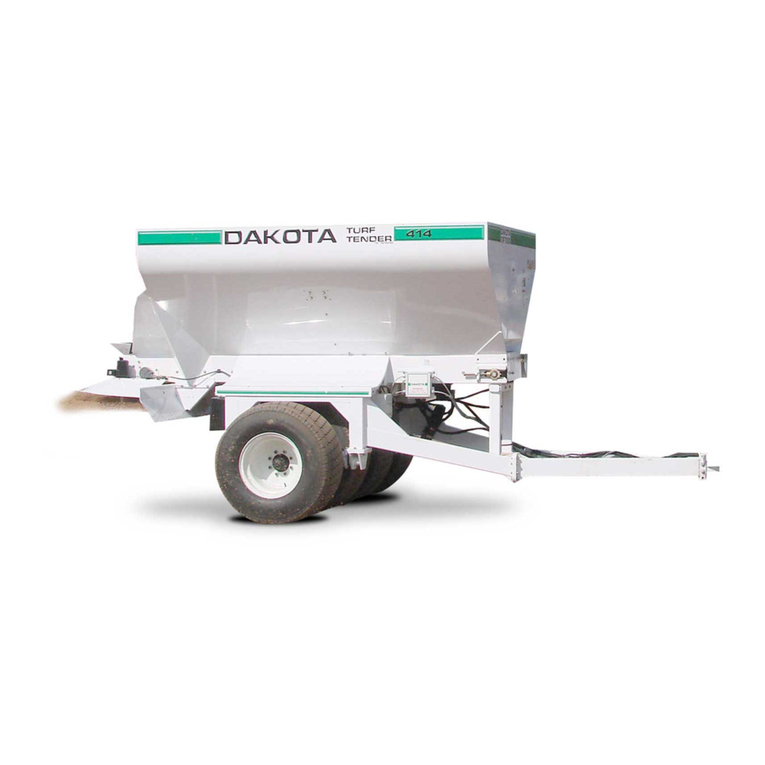
7
GENERAL INFORMATION
TIRES
Check the tires frequently for cracks, checks, and proper
inflation.An under inflated tire poses a significant tipping and
braking hazard and may cause an accident, injury and death.
Donotattemptto jack orperformtiremaintenancewith material
inthe hopper.The recommended tirepressure operating range
is 8-15 psi (55-103 kPa). Do not exceed the maximum tire
pressure listed. Tire pressure is an indication of the ground
pressure the Turf Tender has on turf; however, using a tire
pressure which is too low may cause tire problems and also
result in nonuniform ground pressure at the tire’s face.
MAINTAIN SAFE OPERATING
CONDITIONS
Check the conveyor belt for stretch and proper alignment;
adjust accordingly. The conveyor belt has a V-belt vulcanized
to the back side of the belt to help maintain proper alignment
and carry most of the load; however, it is still necessary to
check and adjust (if necessary) belt alignment.
Do not allow hydraulic fluid to come in contact with the
belt. The PVC belt material is resistant to fertilizers, but
hydraulic fluid causes the PVC coating on the belt to
decompose.
RELIEVE HYDRAULIC PRESSURE
Before performing any work on the hydraulic system, all
pressure in the system must be relieved by releasing the
engagement handle and turning the Turf Tender engine OFF.
Residual hydraulic pressure may still be present, so care
must be taken.
KEEP TURF TENDER CLEAN
Keep the Turf Tender free of excessive grass, leaves, and
accumulations of dirt and sand. Materials such as this can
compromise seals and bearings.
REPLACEMENT PARTS
To ensure optimum performance and safety, always
purchasegenuineDAKOTAreplacementpartsand accessories.
NEVER USE “WILL-FIT” REPLACEMENT PARTS AND
ACCESSORIES MADE BYOTHER MANUFACTURERS.
Using unapproved replacement parts and accessories voids
the warranty of the DAKOTA Turf Tender.
TOWING THE TURF TENDER
Never tow the Turf Tender. Towing the Turf Tender results
in hydraulic pressure being built up and will cause damage to
the hydraulic components which will not be covered under
warranty.
GENERALINFORMATION
Owners and operating personnel must thoroughly read and
understand this manual in order to properly operate, lubricate,
and maintain the Turf Tender. Failure to do so could result in
personal injury or equipment damage. Refer to this manual as
frequently as necessary.
LABELINGAND TERMINOLOGY
The Turf Tender and this manual use the following terms
and symbols to bring attention to the presence of hazards of
various risk levels and important information concerning the
use and maintenance of the Turf Tender.
WARNING:Indicatespresence ofahazardwhichcan cause
severe personal injury, death, or substantial property damage
ifignored.
CAUTION: Indicates presence of a hazard which will or
cancause minorpersonal injuryor propertydamage if ignored.
NOTE: Indicates supplementary information worthy of
particular attention relating to installation, operation, or
maintenanceof theTurfTender but isnot relatedto a hazardous
condition.
Besure to followall instructions andrelated precautions as
they are meant for your safety and protection.
This manual is considered a permanent part of the Turf
Tender and must remain with the Turf Tender when sold.
Useonly the correctreplacement parts andfasteners. Right
andleft-hand sides are determined byfacing inthe direction of
the steering wheel.
Record the model and serial numbers in the
specifications section so they are readily available when
contacting a dealer for parts or service. Many owners
employ the dealer’s Service Department for all work other
thanroutine care, cleaning,and adjustments.We stronglyurge
the use of genuine DAKOTA parts to protect the investment
in your Turf Tender.
Ourwarranty isprovided tosupport customers who operate
andmaintain theirequipment as describedin thismanual. This
warranty provides you theassurance that DAKOTAwill back
its products where defects appear within the warranty period.
Should the equipment be abused, or modified to change its
performance beyond the original factory specifications, the
warranty will become void and field improvements will be
denied.
AUTHORIZED MAINTENANCE
Performonly themaintenance described in this manualthat
you are qualified to perform. If major repairs are ever needed
orassistanceisdesired,contactanAuthorizedDAKOTADealer
for their professional service.
UNLOAD HOPPER PRIOR TO DOING
MAINTENANCE
Any material in the hopper must be removed prior to
performing maintenance on or beneath the Turf Tender.
POWER OFF MAINTENANCEAND
ADJUSTMENTS
All maintenance and adjustments to the Turf Tender must
be made with the engine off.




























